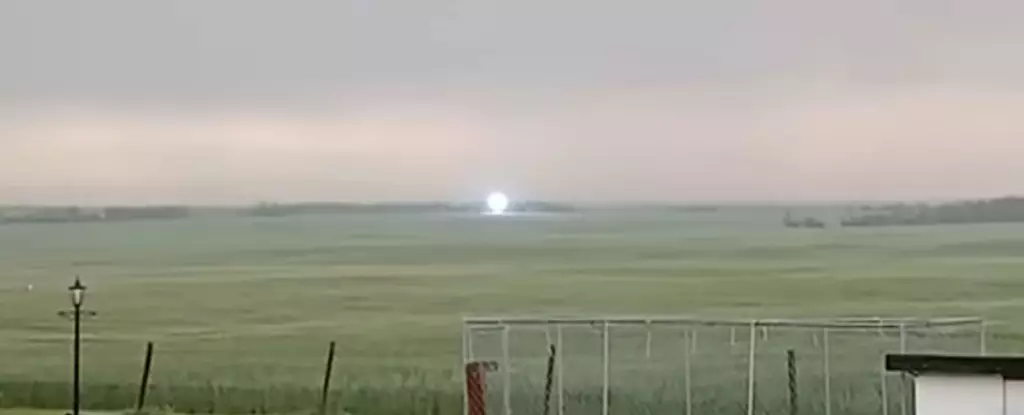Storms have long fascinated humanity, simultaneously terrifying and awe-inspiring us with their raw energy and unpredictable displays. Among these, lightning is perhaps the most dramatic and visually stunning aspect, illuminating the skies with brilliant flashes. Yet, what lurks beyond the obvious? Hidden within the chaotic brilliance are phenomena that challenge our understanding and ignite our curiosity. The recent sighting by Ed and Melinda Pardy exemplifies this, illustrating how nature occasionally reveals glimpses of its deepest mysteries—phenomena that strike at the core of scientific inquiry and human wonder.
This incident underscores how nature’s most extraordinary displays often defy straightforward explanation. The couple’s recording of a luminous blue orb hovering near the strike site offers a tantalizing glimpse into phenomena that might be more than just coincidence. It prompts us to question whether what we see on weather maps and in meteorological models truly encompasses the full spectrum of atmospheric phenomena. When confronted with such anomalies, the instinct to dismiss them as mere optical illusions or equipment malfunctions reveals a limited understanding of the vast complexity of atmospheric physics.
Furthermore, the incident serves as a reminder that our scientific grasp of these phenomena remains incomplete. Despite centuries of careful observation and modern technological advancements, some atmospheric events stubbornly resist classification, reminding us that nature retains a sense of mystery. This could also indicate that our current scientific models are, at best, partial representations of reality. It’s a humbling realization that, even with all our probe-equipped satellites and laboratory experiments, the universe continues to surprise us, challenging our assumptions and beckoning us toward deeper exploration.
Questioning Science, Embracing the Unknown
The phenomenon captured by the Pardy couple sparks an essential debate about the limits of scientific knowledge. Is this just another fleeting ball lightning, or something entirely different—an undiscovered aspect of atmospheric physics? The scientific community remains divided, partly because of the rarity of such events and partly because of the technological limitations involved in studying them. While some experts suggest the orb could be a form of ball lightning—a phenomenon that has eluded definitive scientific explanation—others remain skeptical, proposing alternative explanations rooted in human perception or localized environmental effects.
What makes this incident particularly compelling is the shared anonymity of eyewitnesses throughout history, countless accounts of glowing orbs, fiery spheres, and strange lights appearing suddenly during thunderstorms. These stories often carry a tone of mysticism, but they also suggest that such phenomena may not be mere hallucinations or optical errors. Instead, they point towards a real, albeit poorly understood, natural phenomenon that could shed light on plasma physics, atmospheric electricity, or even previously unknown interactions between Earth’s surface and its electrical environment.
Biased skepticism, however, remains strong. Critics argue that many of these sightings are misidentified electrical artifacts or visual glitches. While on the surface this might seem plausible, dismissing them outright neglects the accumulated anecdotal evidence stretching across cultures and generations. These aren’t isolated incidents; they are part of a collective human experience that points to the existence of extraordinary natural phenomena deserving serious scientific investigation. Denying their legitimacy due to current limitations prevents us from unlocking potential breakthroughs in understanding atmospheric physics.
Future Perspectives: From Mysteries to Scientific Breakthroughs
The quest to understand such anomalous electrical phenomena reflects an essential characteristic of human curiosity—a willingness to confront the unknown rather than shy away from it. Advances in instrumentation, experimental modeling, and international collaboration might someday unravel the mysteries surrounding these luminous orbs. For instance, innovative laboratory experiments attempting to replicate ball lightning have yielded intriguing results, such as the presence of vaporized soil particles or plasma formations, hinting at complex mechanisms yet to be fully understood.
Crucially, these mysteries challenge established scientific paradigms and inspire fresh approaches. Recognizing that phenomena like the one captured in Alberta are genuine, natural occurrences pushes research beyond traditional boundaries. It emphasizes the importance of engaging in cross-disciplinary efforts—bridging meteorology, plasma physics, and atmospheric chemistry—to develop comprehensive models. The scientific community should embrace the possibility that these enigmatic orbs might serve as windows into unseen processes at work in Earth’s atmosphere—processes that might have implications for understanding electrical storms, climate dynamics, or even the Earth’s magnetic environment.
The enduring allure of these phenomena fuels scientific passion and curiosity, driving experimentation and theoretical exploration. The more we uncover about these flashing mysteries, the closer we get to understanding the underlying physics—not just for their sake, but for what they reveal about our planet’s intricate and astonishing natural systems. Instead of dismissing these sightings as mere anomalies, the scientific community should approach them as opportunities for discovery—beacons guiding us through the storm of ignorance toward the dawn of enlightenment.

